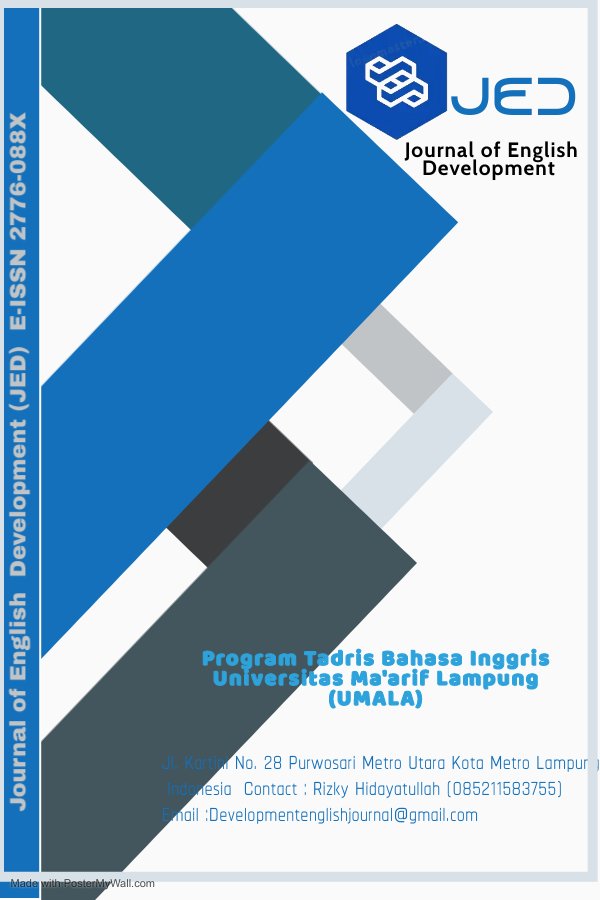The Efficacy of Using Comics Strips in Reading Class at MA Ma'arif Roudlotut Tholibin
English
DOI:
https://doi.org/10.25217/jed.v3i01.4008Keywords:
Effivacy,Comic Strips, ReadingAbstract
This study aims to determine whether using comic strips in instructional activities improves students' reading comprehension, particularly when it comes to narrative texts. This study employed a quasi-experimental design in a quantitative manner. Students from MA Ma'arif Roudlotuth Tholibin, with two sample classes of 20 students each, made up the study's population. There was an experimental class and a control class assigned to both classes. The pre- and post-test methods were used to gather the data. The computation in this study indicated that comic strips are a useful teaching and learning tool for narrative text. The experimental class's mean post-test score, which was 70.40 while the control class's score was 68.17, confirmed this conclusion. This suggests that the post-test mean for the experiment class (70.40>68.17) was higher than the control class's. As a result, the statistics showed that 1.937 > 1.67= tobserve > ttable, proving that The Alternative Hypothesis (Ha) is accepted and the Null Hypothesis is rejected.. In conclusion, using comic strips to instruct students in reading comprehension of narrative texts is an effective strategy to raise their reading skill.
References
Arikunto, S. (2010). Prosedur penelitian suatu pendekatan praktek. (No Title).
Boldt, G., & Leander, K. M. (2020). Affect theory in reading research: Imagining the radical difference. Reading Psychology, 41(6), 515–532.
Harvey, R. C. (1996). The art of the comic book: An aesthetic history. Univ. Press of Mississippi.
Hullah, P. (2018). We Found Her Hidden. Partridge Publishing Singapore.
Kaan, E., Ballantyne, J. C., & Wijnen, F. (2015). Effects of reading speed on second-language sentence processing. Applied Psycholinguistics, 36(4), 799–830.
Kim, M. (2004). Literature discussions in adult L2 learning. Language and Education, 18(2), 145–166.
Layli, R. Y., Rofi’ah, S., & Makrifah, I. A. (2024). The Developing a Guessing Game to Improve Speaking Skills for Grade 9th In Mts Al-Hidayah Sukonolo Bululawang: English. Journal of English Development, 4(01), 182–193.
Pantrisia Surtika Sari, Widiarini, Rofi’ah, S., & Makrifah, I. A. (2022). Developing of Android Based Educational Games as a Supplementary Media For Vocabulary of Junior High School Students. Journal of Development Research, 6(1), 118–124. https://doi.org/10.28926/jdr.v6i1.161
Rahadianto, P. (2019). Enhancing Vocabulary Mastery Using a Computer-Based Game for Teaching English To Young Learners (Teyl). Karya Ilmiah Dosen, 2(2).
Rengur, Z., & Sugirin, S. (2019). The effectiveness of using comic Strips to increase students’ reading comprehension for the eighth grade students of SMPN 1 Pundong. 6th International Conference on Educational Research and Innovation (ICERI 2018), 511–515.
Rokhayani, A., & Utari, A. R. P. (2014). The use of comic strips as an English teaching media for junior high school students. Language Circle: Journal of Language and Literature, 8(2).
Šťastná, A. (2018). Learning English through online leisure activities by secondary school pupils. Masarykova univerzita, Pedagogická fakulta.

Downloads
Published
How to Cite
Issue
Section
License
Copyright (c) 2024 Irma Triana, Wiwed Pratiwi, Rizky Hidayatullah

This work is licensed under a Creative Commons Attribution-ShareAlike 4.0 International License.





